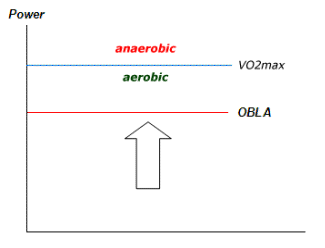Lactate Threshold
This article should be read in conjunction with its bigger brother, Lactate Testing & Training. There are many contradictions and inconsistencies to the understanding of lactate definition, production and flushing. Confusion surrounds this subject like no other.
Please read this factsheet to buy in to the concepts, then read the follow on factsheet for more in-depth and factual based content. It's not to say that what is here is wrong, it's just that this factsheet feeds certain stereotypes and analogies that need further clarification if you are to get the best from your training.
The Stereotypical Concept
Lactate Threshold is a term used to loosely describe the point at which it begins to hurt more than it should. Think of it as the transition from comfortably hard to hardly comfortable. Loads of people have loads of different interpretations of what it is and what it should be called but for the sake of this "simplified" factsheet we will call it your Lactate Threshold and describe it as:
"the point at which your lactate production overcomes
your body's ability to flush it away".
your body's ability to flush it away".
One of the commonly accepted scientific definitions is when the measurement of lactate within the blood passes 4millimols/litre.
Lactate Acid?
This is a very simple explanation for a very complex process but it's the concept of what's happening that we need to understand. So, imagine this two-part scenario:
As we ride our bike at a moderate pace, we breath moderately and in doing so supply a moderate amount of oxygen to our muscles, which produce moderate amounts of lactate. At the lower end of cycling intensity we take in more oxygen than we really need. This under utilized oxygen makes itself useful and carries away the by-product of our muscle activity, commonly called lactate acid.As we increase our pace our muscle's demand for oxygen increases. Our breathing rate rises to meet our body's demands and lactate acid production begins to escalate. This is where our troubles start. As lactate acid increases and the oxygen availability to carry it way decreases. There comes a time when the oxygen flushing capacity is overwhelmed by lactate acid production and pools begin to form within our muscles. This is often called our Lactate Threshold.
It's been recognised that once the blood concentration passes the 4millimol barrier many physiological issues arise. There's no need to concern yourselves with them too much, all you are worried about is the outcome. Basically it's this; power and speed drop ~ hurt and suffering increase.
Where's my threshold?
The point in all of us where lactate acid begins to accumulate rapidly, to a point of debilitation happens before we reach our theoretical aerobic ceiling or VO2max. It's at what point of our VO2max this rapid accumulation starts, our lactate threshold, that determines how well we race. A graphic example of people reaching their lactate thresholds can be seen on a hill of any race when the hammer goes down. The one's that have hit it are the ones going backwards.
For less well trained athletes, lactate threshold is around 60% of their VO2max. For the better trained, it's around 65-80%; and for elite riders and the Pro Tour boys, it's 85-90% of their incredibly high VO2max. So they have a double whammy over us. Not only do they have a greater capacity, they can use more of it before hitting their thresholds.
 What do I do with it?
What do I do with it?If you knew exactly your onset point
of debilitation you could vary your racing strategies and tactics to suit your strengths.
In a time trail you could cruise just below your threshold and maintain the same power output or heart rate for the duration of your time trial. This is infinitely better than going over your threshold, dropping back when the legs give out and then trying to go again when, or if, the feeling came back. I really recommend you check out our Time Trial Strategy factsheet for a better explanation of this concept.
In a road race or criterium you could attack and maintain a sustained charge right on your threshold limit. If you didn't stay away at least you'd know you gave it everything you safely could. And if you were caught you'd at least have enough left to jump back on and go again later. Without the knowledge of your threshold point; you attack, you wildly crash through your lactate power threshold, you blow, you get caught, you get dropped.
You can change all this, and vastly swing the odds in your favour, just by knowing your exact lactate threshold power or heart rate point! All it takes is a simple test.
Realising your potential

VO2max (blue line) is best described as our ultimate aerobic potential. Our lactate balance point (red line) is the physiological factor that defines how much of that potential we are allowed to use. VO2max is genetic and plateaus after a couple of seasons training. The one real inhibitor we can all successfully train to expand is our lactate .
Once the base building phase of the season is complete, finding the lactate threshold, working on it, and improving it, should be the ultimate aim of every athlete. The blue line is, to all intents and purposes, genetically fixed. The red line can be driven up quite dramatically and quickly once you train at the right intensity, duration and effectiveness.
Finding your threshold
 Lactate acid is produced constantly by your body . Even while you are sitting there reading this your body is producing lactate acid; because we aren't exercising and have loads of oxygen going spare we never even notice. But once we start exercising production ramps up. By carrying out a Lacate Performance Test we can determine the individual power output, speed or heart rate at which point our lactate threshold is reached.
Lactate acid is produced constantly by your body . Even while you are sitting there reading this your body is producing lactate acid; because we aren't exercising and have loads of oxygen going spare we never even notice. But once we start exercising production ramps up. By carrying out a Lacate Performance Test we can determine the individual power output, speed or heart rate at which point our lactate threshold is reached. Once we know where our lactate threshold is we can do something about improving it. It isn't easy but then if it was easy everyone would be doing it!
Developing your threshold
To develop your threshold you obviously have to exercise hard, in the right training zone, for the right amount of time with the right amount of recovery. You also need to fuel the engine. Undertaking lactate threshold training while dehydrated or with depleted glycogen stores will seriously affect the quality of your sessions and the subsequent results.
To maximise the benefits of your lactate threshold development programme you should have spent a significant time during the building phase of your training riding at a low intensity. Riding at a speed you would consider to be too slow to train provides the potential for the development of the following attributes:
▼ a higher density of muscle mitochondria
▼ a developed fatty acid oxidation system
▼ an increased muscle capillary density
▼ the conversion of fast twitch muscle fibres to slow
Also, with the correct attention being paid to pedalling techniques it's possible to recruit more muscles in to the pedalling action. A large muscle mass working moderately will create less lactate per watt generated than a smaller muscle mass working vigorously.
So when the time comes to do your lactate development intervals; using more muscles, with a higher density of mitochondria, that have the ability to spare glycogen, and have a greater proportion of muscle fibres ready to fire will obviously bring spectacular results.
Developing your mitochondria production gives two benefits for the price of one. Not only does the oxygen get to your muscles quicker, due to the higher density, once they've dropped off their power giving oxygen they are then free to remove the debilitating lactate acid. All this just from riding slow!
The message
Undertaking a Lactate Threshold Test is extremely useful but only if you do something practical with the information you have.
Devising a training plan with the specific requirements of increasing your lactate threshold is a fantastic investment in your training time. But only if you know where your threshold is to begin with; otherwise how will you know how hard to go and how will you know if you've improved it?
Through increasing your cycling economy, lactate tolerance and power output you can make significant improvements in the efficiency of your aerobic engine thus allowing you to cruise at a faster speed. We haven't raised the ceiling but we've increased the percentage of the level we can use before lactate pooling begins. And that's what wins races.
No comments:
Post a Comment